So, you’ve made the decision to come and learn Spanish in Madrid. Great choice!
The city has so much to offer, and, being one of the biggest cities in Europe, it has an excellent red de transporte (transport network) to help you moverse por la ciudad (move around the city). This blog will guide you through the different transport options available here and teach you some useful vocab so you don’t perderse (get lost) while you’re out and about exploring!
Types of transport vocabulary
First of all, let’s take a look at some basic vocabulario (vocabulary). Here are the different types of transport you can take in Madrid:
| Español | Inglés |
| el autobús / el bus | the bus |
| el tren de cercanías | the local train |
| el metro | the underground/subway |
| un taxi | a taxi |
| un vehículo de transporte con conductor (VTC) | a vehicle for hire (meaning Uber, Cabify, etc here in Spain) |
| un patinete eléctrico | an electric scooter |
As you can see, there are muchas opciones (many options) to choose from. Madrileños (People from Madrid) love their public transport, but many people also opt to drive around the city too. We wouldn’t recommend it for a temporary visit to the capital as there’s lots of tráfico (traffic) and you must also make sure you’re carnet de conducir (driving licence) is valid to use in Spain. It’s always best to check things like this on the website of the Dirección General de Tráfico (DGT) which is the government body in charge of regulating the roads in the country.
Now let’s take a look at the different types of transport and how to use them while you’re studying Spanish in Madrid.
El autobús
There are over 200 líneas de autobús (bus lines) in the capital which serve the whole city from north to south, east to west. Our local public bus company is the EMT and they provide an almost 24-hour service. In the day, you can catch any of the numbered routes from 1 to 191, and by night the bus nocturno (night bus) runs on 27 routes which cover most of Madrid.
You can buy un billete sencillo (a single ticket) for just €1.50 which allows you to coger (take) any bus from the beginning to the end of the route. Bargain! There are also several abonos (passes) available such as the Bus+Bus which gives you 10 bus trips with un transbordo (a change) of line per journey for €18.30, or the Metrobus that provides 10 trips on either the bus or the underground for €12.20 but it does require a special tarjeta (card) that you have to buy first. We’ll explain more about that later.
Day routes run from 6am to 1130pm in the week, and from 7am to 11pm at weekends. After this, the nocturnos (night buses) take over but all the same tickets are still valid on these. The bus is always a great way to explorar (explore) any new city you go to live in, and Madrid is no exception. We’d definitely suggest you find your local paradas (bus stops) when you’ve moved here to start your Spanish course and have a good look around your new home!
Apart from the local buses, the Madrid area has a huge amount of interurbanos (regional buses) which can take you all over the Comunidad de Madrid and beyond. You can use the same abonos (passes) as on the local buses and all the same zones apply as to the metro and local trains which we’ll talk about in the next section.
El metro
The Metro de Madrid (Madrid subway/underground) is one of the oldest and most extensive in the world. It was inaugurado (opened) on 17 de octubre (17th October) 1919 by the then king, Rey Alfonso XIII (King Alfonso 13th). There are 330 estaciones (stations), 12 líneas (lines) and 3 líneas de metro ligero (light rail) covering not only Madrid but also several of the neighbouring towns and cities. It’s fast, clean and efficient so it’s ideal to get around town in a hurry.
Like on the buses, un billete sencillo (single ticket) starts at €1.50 but can go up to €2 depending on the route. You need to buy una tarjeta multi (a multi-card) which costs €2.50 to be able to purchase any metro tickets, but this card never expires and you can load all sorts of different ticket options onto it. Lots of people buy the aforementioned Metrobus for €12.20 to get 10 viajes (trips) on both the underground and any city buses.
If you’re planning to stay for a long period, you might want to think about buying un abono mensual (a monthly pass). These require photo ID to get, but they allow you unlimited travel across all underground, bus and local train lines within certain zones. Zona A (Zone A) covers the entire city of Madrid and costs just €54,60 per month, or the abono joven (Young Person’s Pass) lets you travel through Zones A-E2 for only €20 if you’re under 26. Zone E2 goes all the way out to the beautiful city of Toledo (which you can read about in another blog) so it’s an absolute steal!
El tren
The train network in Madrid and los alrededores (the surrounding area) is very extensive and has great connections to many of the most important towns and cities nearby. There are several types of trenes (trains) in Madrid and Spain – los trenes de cercanías (local trains), media o larga distancia (regional and national trains) and los AVE (high speed trains). These have different pricing structures, just like in any country, so you’d need to check which billete (ticket) you need on the website of the national train company, RENFE.
If you want to explore Madrid and its local area, the cercanías (local trains) are reliable, frequent and cheap. A billete de ida (one-way ticket) for one or two zones costs €1,70 and goes up from there depending on how many zones you need to cross. There are billetes de ida y vuelta (return tickets) on the local trains but they’re basically two one-way tickets as they cost double. Like on the metro and bus network, you can use your monthly abono (pass) on all local trains. For any media o larga distancia (regional and national trains) or AVEs (high speed trains) you need a ticket specifically for the train you want.
El taxi o el VTC
Both taxis and private hire cars (e.g. Uber) are very popular in the city. You can parar (flag down – literally to stop) a white city taxi anywhere by waving at them when you see one in the street. All other types of private hire vehicles must be reservados (reserved) by using that company’s app. Obviously, both of these options are more expensive than catching transporte público (public transport), but good if you need to get somewhere that’s a bit far from the closest parada (stop) of either a bus, train or underground.
Right, now we’ve given you a bit of an overview of how you can desplazarte (move around) while you’re here at Hablamos on one of our Spanish courses, let’s take a look at some useful phrases you might need to use all these forms of transport.
| Español | Inglés |
| ¿Dónde está la parada de bus/metro más cercana? | Where’s the nearest bus/subway stop? |
| ¿Hay una estación de tren por aquí? | Is there a train station near here? |
| ¿Dónde se puede tomar un taxi por aquí? | Where can you get a taxi from around here? |
| ¿Cuánto cuesta un billete de ida/de ida y vuelta a___? | How much is a single/return ticket to___? |
| Quiero un abono mensual para la zona ___ por favor. | I want a monthly pass for zone ___ please. |
| ¿Este bus para en/cerca de ___? | Does this bus stop in/near ___? |
| ¿Este es el andén dirección ___? | Is this the platform for ___? |
| ¿Este tren para en ___? | Is this the train for ___? |
| Me llevas a ___ por favor | Please take me to ___ |
That’s all your transport needs sorted, now sign up on one of our language courses and come explore Madrid for yourself!





